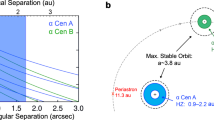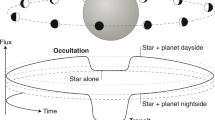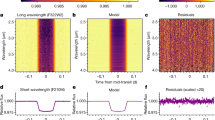Abstract
WE report results from the first stellar occultation by Titan ever observed. As predicted by Wasserman1, on 3 July 1989 the bright star 28 Sagittarii (visual magnitude, V ≈ 5.5), passed behind Saturn's giant moon ( V ≈ 8.3), which is the only body in the Solar System that, like the Earth, has a dense, nitrogen-rich atmosphere2. The event, visible from Europe, North Africa and the Middle East, allowed us to probe Titan's atmosphere in an altitude range of ∼ 250–500 km (a pressure range of ∼250-1 μbar), where until now, there has been an 'information gap' between infrared and ultraviolet Voyager observations3–5. We also detected a central flash as the centre of Titan's shadow passed at a few tens of kilometres from Paris. This central flash allows us to estimate a finite oblateness of Titan's stratosphere, which could arise from a super-rotation of Titan's atmosphere.
This is a preview of subscription content, access via your institution
Access options
Subscribe to this journal
Receive 51 print issues and online access
$199.00 per year
only $3.90 per issue
Buy this article
- Purchase on Springer Link
- Instant access to full article PDF
Prices may be subject to local taxes which are calculated during checkout
Similar content being viewed by others
References
Wassermann, L. H. IAU Circ. No. 4761 (1989).
Hunten, D. et al. in Saturn (eds Gehrels, T. & Matthews, M. S.) 671–759 (University of Arizona Press. 1984).
Lindal, G. F. et al. Icarus 53, 348–363 (1983).
Hanel, R. A. et al. Science 212, 192–200 (1981).
Broadfoot, A. L. et al. Science 212, 206–211 (1981).
Hubbard, W. B. et al. Nature 343, 353–355 (1990).
Elliot, J. L. et al. Icarus 77, 148–170 (1989).
Burns, J. in Satellites (eds Burns, J. & Matthews, M. S.) Ch. 1 (University of Arizona Press, 1986).
Lellouch, E. et al. Icarus 79, 328–349 (1989).
Owen, T. C. Planet. Space Sci. 30, 833–838 (1982).
Elliot, J. L. A. Rev. Astr. Astrophys. 17, 445–475 (1979).
Lellouch, E., Hunten, D. M., Kockarts, G. & Coustenis, A. Icarus (in the press).
Elliot, J. E. et al. Astrophys. J. 217, 661–679 (1977).
Lellouch, E., Hubbard, W. B., Sicardy, B., Vilas, F. & Bouchet, P. Nature 324, 227–231 (1986).
Hubbard, W. B. et al. Icarus 72, 635–646 (1987).
Hubbard, W. B. et al. Astrophys. J. 325, 490–502 (1988).
Conrath, B. J. in The Atmospheres of Saturn and Titan, ESA Sci. Publ. 241 (eds Rolfe, E. & Battrick, B.) 83–94 (European Space Agency, 1985).
Wenkert, D. D. & Garneau, G. V. Bull. Am. astr. Soc. 19, 875 (1987).
Flasar, F. M., Samuelson, R. E. & Conrath, B. J. Nature 292, 693–698 (1981).
Coustenis, A., Bézard, B. & Gautier, D. Bull. Am. astr. Soc. 21, 959 (1989).
Author information
Authors and Affiliations
Rights and permissions
About this article
Cite this article
Sicardy, B., Brahic, A., Ferrari, C. et al. Probing Titan's atmosphere by stellar occultation. Nature 343, 350–353 (1990). https://doi.org/10.1038/343350a0
Received:
Accepted:
Issue Date:
DOI: https://doi.org/10.1038/343350a0
This article is cited by
-
A review of Titan’s atmospheric phenomena
The Astronomy and Astrophysics Review (2009)
-
Cassini Imaging Science: Instrument Characteristics And Anticipated Scientific Investigations At Saturn
Space Science Reviews (2004)
-
Exploring The Saturn System In The Thermal Infrared: The Composite Infrared Spectrometer
Space Science Reviews (2004)
-
An occult view of Titan
Nature (1990)
Comments
By submitting a comment you agree to abide by our Terms and Community Guidelines. If you find something abusive or that does not comply with our terms or guidelines please flag it as inappropriate.



